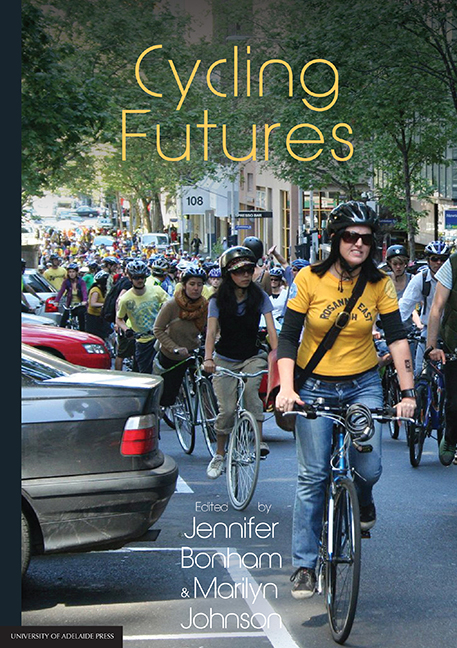Book contents
- Frontmatter
- Contents
- Preface
- Editors
- Contributors
- PART I Current challenges
- 1 Cycling: Bringing the future into the present
- 2 A glimpse at Australia's cycling history
- 3 Health benefits of cycling
- 4 An epidemiological profile of cycling injury in Australia and New Zealand
- 5 Faster than the speed of bikes
- 6 Economics of everyday cycling and cycling facilities
- 7 Cycling and sustainable transport
- 8 Cycle touring
- PART II Strategies for change
5 - Faster than the speed of bikes
from PART I - Current challenges
Published online by Cambridge University Press: 25 July 2017
- Frontmatter
- Contents
- Preface
- Editors
- Contributors
- PART I Current challenges
- 1 Cycling: Bringing the future into the present
- 2 A glimpse at Australia's cycling history
- 3 Health benefits of cycling
- 4 An epidemiological profile of cycling injury in Australia and New Zealand
- 5 Faster than the speed of bikes
- 6 Economics of everyday cycling and cycling facilities
- 7 Cycling and sustainable transport
- 8 Cycle touring
- PART II Strategies for change
Summary
Introduction
Speed is a major contributing factor in on-road crashes. Vehicle speed, excessive speed and speed inappropriate for the conditions are known to contribute to road crashes and human trauma (Elvik, Christensen, & Amundsen, 2004; Aarts & Van Schagen, 2006). However, little is known about the speed of cyclists. Cyclists’ travel speed, drivers’ perceptions of cyclist speed and the potential role of cyclists’ speed in relation to safety are poorly understood. It is likely that the travel speed of a cyclist will impact cyclist safety and directly impact how drivers and cyclists interact on the road. For example, if drivers underestimate how fast a cyclist is travelling, they may be more likely to underestimate the distance they needed to turn safely in front of a cyclist, or the time available to open a vehicle door.
For cyclists, speed varies constantly and many factors play a role. The cyclist's wellbeing is a major factor in terms of level of fitness, exertion or fatigue. Terrain directly influences speed; a hill that slows a rider going up provides a free ride down on the return trip. At times cyclists are slowed by headwinds and crosswinds and deterred by rain, and at other times they are helped along by tailwinds and encouraged by warm sunshine (see Kingham and Tranter, Chapter Seven, this volume). Unlike a driver who is cocooned from their environment, the cyclist is exposed to enjoy or combat the elements. The mechanics of the bike, the tyre pressure, bike geometry and the cyclist's position on the bike — upright or tucked over drop handlebars — can also play a part. In addition, the purpose of a trip can increase or decrease the speed a cyclist travels: a daily commute is likely to be travelled at a different speed to a social ride with friends or children on the weekend (van Ingen Schenau, 1988; Hennekam, 1990; Grappe et al., 1999; Thornley, Woodward, Langley, Ameratunga, & Rodgers, 2008).
- Type
- Chapter
- Information
- Cycling Futures , pp. 89 - 106Publisher: The University of Adelaide PressPrint publication year: 2015

